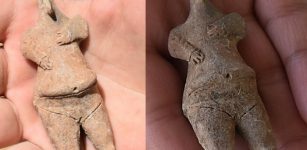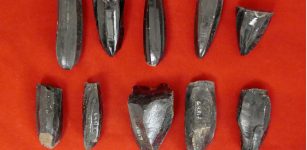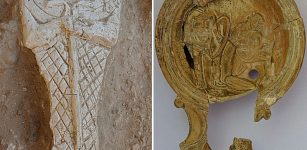History Of The Saltire – Scotland’s National Flag And World’s Oldest Sovereign Flag
AncientPages.com - Most people have seen the Saltire, Scotland's national flag. With its symbol as a diagonal cross, the blue flag is easily recognizable. Not everyone knows the exciting history of the Saltire, the world's oldest sovereign flag.
The history of the Saltire can be traced to an ancient legend and St Andrew, the patron saint of Scotland.
It is believed that in 832 AD, a Pictish army under King Angus MacFergus, High King of Alba, along with a force of Scots under Eochaidh, King of Dalriada, came up against a Northumbrian force under King Aethelstan of East Anglia in Lothian.
The Pictish army had little chance of winning the battle. Superior numbers surrounded them, and the soldiers prayed for assistance. That night Saint Andrew, who was martyred on a Saltire-shaped cross, appeared to Angus and assured him of victory. The following day something extraordinary happened. When the two forces prepared for the battle, an image of a white cross suddenly appeared in the sky.
The battle site is known as Athelstanford after the Northumbrian leader, who was killed in the battle. The image encouraged the Picts and gave them strength and courage. The Northumbrian army became terrified and fled in panic. From then onwards, the Saltire has been used as Scotland's national flag.
The Saltire is Scotland's national flag
Today, the Saltire is also referred to as St Andrew's cross. St Andrew was an agile and hardy Galilean fisherman whose name means Strong and had good social skills. He brought the first foreigners to meet Jesus and shamed a large crowd into sharing their food with the people beside them. As one of the disciples of Christ, he became a missionary in Asia and Greece before the Romans crucified him at Patras in 69 AD.
Legend tells that St. Andrew felt unworthy to be crucified on a cross similar to Jesus and demanded to die on an X-shaped cross instead.
St Andrew was a Galilean fisherman - Image via Saint Andrew
His remains were interred in Constantinople but later removed by St Rule (Saint Regulus or Saint Rule (Old Irish: Riagal), a legendary 4th-century monk or bishop of Patras, Greece, who in AD 345 is said to have fled to Scotland.
St Rule was told to take the remains to the 'ends of the earth' for safekeeping. He removed a tooth, arm bone, kneecap, and some fingers from the tomb and set off for the most remote place he could find. That place was on Scotland's east coast and has become known as St Andrews.
The relics were later destroyed during the Reformation, and most of the other remains were stolen from Constantinople and moved to Amalfi in Italy. Some of these relics finally came to Scotland in 1879 and 1969.
It is the story of how the Saltire became the flag of Scotland.
To have Saint Andrew as Scotland's Patron gave the country several advantages. Since St Andrew was the brother of Saint Peter, founder of the Church, the Scots were able to appeal to the Pope in 1320 (The Declaration of Arbroath) for protection against the attempts of English kings to conquer the Scots.
Traditionally, Scots also claimed that they descended from the Scythians, who lived on the shores of the Black Sea in what is now Romania and Bulgaria and were later converted by Saint Andrew.
The Saltire was an important religious symbol. It was worn by Scottish crusaders to the Holy Land and incorporated into their coats of arms. Many Scottish noble families adopted the Saltire this way; Bruces, Johnstones, Kirkpatrics, and some Norman families.
In the 1707 Act of Union, Scotland and England became the United Kingdom. A new flag was designed that united the crosses of St Andrew and St George.
The memory of St Andrew is still very much alive. Scotland celebrates St Andrew on 30 November every year. St Andrew has been the patron saint of Scotland for over 1,000 years.
He is also the patron saint of Romania and Russia.
Copyright © AncientPages.com All rights reserved. This material may not be published, broadcast, rewritten or redistributed in whole or part without the express written permission of AncientPages.com
Expand for referencesMore From Ancient Pages
-
 Garden Of Eden And Its Four Rivers – Possible Locations Of Biblical Paradise Suggested By Archaeologists, Historians And Biblical Scholars
Biblical Mysteries | May 29, 2017
Garden Of Eden And Its Four Rivers – Possible Locations Of Biblical Paradise Suggested By Archaeologists, Historians And Biblical Scholars
Biblical Mysteries | May 29, 2017 -
 Lhasa’s Potala Palace: Greatest Building In Tibet With History Of 1300 Years
Civilizations | Nov 23, 2018
Lhasa’s Potala Palace: Greatest Building In Tibet With History Of 1300 Years
Civilizations | Nov 23, 2018 -
 12,000-Year-Old Archaeological Evidence Of Human-Dog Friendship In Alaska
Archaeology | Dec 5, 2024
12,000-Year-Old Archaeological Evidence Of Human-Dog Friendship In Alaska
Archaeology | Dec 5, 2024 -
 Takshashila: Renowned Learning Center That Attracted Buddhist Masters, Disciples And Students Of The World
Featured Stories | Jul 23, 2016
Takshashila: Renowned Learning Center That Attracted Buddhist Masters, Disciples And Students Of The World
Featured Stories | Jul 23, 2016 -
 12,000-Year-Old Ice Age Stone Tools Found – Earliest Dated Evidence For Human Activity in Scotland
Archaeology | Oct 10, 2015
12,000-Year-Old Ice Age Stone Tools Found – Earliest Dated Evidence For Human Activity in Scotland
Archaeology | Oct 10, 2015 -
 Discovery: Massive Gawro Wall Dated To The Antique Age: Was It A Symbolic Or Defensive Structure?
Archaeology | Nov 9, 2019
Discovery: Massive Gawro Wall Dated To The Antique Age: Was It A Symbolic Or Defensive Structure?
Archaeology | Nov 9, 2019 -
 Vikings’ Hideouts, Harbours And Homes: How Norse Warriors Owed Their Success To Their Encampments
Featured Stories | Feb 17, 2023
Vikings’ Hideouts, Harbours And Homes: How Norse Warriors Owed Their Success To Their Encampments
Featured Stories | Feb 17, 2023 -
 Mythical Submerged City Of Ys – Europe’s Own Sodom And Gomorrah
Featured Stories | Feb 1, 2023
Mythical Submerged City Of Ys – Europe’s Own Sodom And Gomorrah
Featured Stories | Feb 1, 2023 -
 7,800-Year-Old Clay Female Figurine Unearthed In Ulucak Mound, Turkey’s Izmir
Archaeology | Aug 17, 2022
7,800-Year-Old Clay Female Figurine Unearthed In Ulucak Mound, Turkey’s Izmir
Archaeology | Aug 17, 2022 -
 New Interpretation Of A 4,000-Year-Old Cemetery In Present-Day Slovakia
Archaeology | Dec 21, 2022
New Interpretation Of A 4,000-Year-Old Cemetery In Present-Day Slovakia
Archaeology | Dec 21, 2022 -
 Mayas Utilized Market-Based Economics – New Study
Archaeology | Jan 6, 2023
Mayas Utilized Market-Based Economics – New Study
Archaeology | Jan 6, 2023 -
 First Human Culture Lasted 20,000 Years Longer Than Thought – New Study
Archaeology | Jan 11, 2021
First Human Culture Lasted 20,000 Years Longer Than Thought – New Study
Archaeology | Jan 11, 2021 -
 On This Day In History: Munich Agreement Was Signed – On Sep 30, 1938
News | Sep 30, 2016
On This Day In History: Munich Agreement Was Signed – On Sep 30, 1938
News | Sep 30, 2016 -
 Intricate And Complex History Of Aqueduct System In Ancient Arles
Archaeology | Jul 18, 2025
Intricate And Complex History Of Aqueduct System In Ancient Arles
Archaeology | Jul 18, 2025 -
 Ancient Sound Of Stones – Acoustics At Stonehenge Tested By Scientists
Ancient Technology | Aug 29, 2020
Ancient Sound Of Stones – Acoustics At Stonehenge Tested By Scientists
Ancient Technology | Aug 29, 2020 -
 Hellenistic Decorated Tombs And Tombstone Probably Used As A False Door Unearthed In Egypt
Archaeology | Jan 10, 2018
Hellenistic Decorated Tombs And Tombstone Probably Used As A False Door Unearthed In Egypt
Archaeology | Jan 10, 2018 -
 Wars Of The Roses: Thirty Two Years Of Struggle To Claim English Throne
Featured Stories | Aug 5, 2017
Wars Of The Roses: Thirty Two Years Of Struggle To Claim English Throne
Featured Stories | Aug 5, 2017 -
 Legend Of The Blue Men Of Minch: Were They Mythological Creatures Or Real Men?
Featured Stories | May 13, 2016
Legend Of The Blue Men Of Minch: Were They Mythological Creatures Or Real Men?
Featured Stories | May 13, 2016 -
 Rare Well-Preserved Viking Artifacts Lost On Mountain Pass – Revealed By Retreating Glaciers
Archaeology | Apr 16, 2020
Rare Well-Preserved Viking Artifacts Lost On Mountain Pass – Revealed By Retreating Glaciers
Archaeology | Apr 16, 2020 -
 Large Collection Of 2,200-Year-Old Tombs With Boat Coffins Made Of Nanmu Wood, Unearthed In SW China
Archaeology | Feb 10, 2017
Large Collection Of 2,200-Year-Old Tombs With Boat Coffins Made Of Nanmu Wood, Unearthed In SW China
Archaeology | Feb 10, 2017



